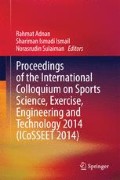Abstract
The ability of Kaedah A as a technique to fend off an attack with bare hands is questionable since the estimated ordinary human minimal reaction time is 0.18 s while the offensive force can reach its target in less than 0.1 s. Therefore, this study aimed to analyze the effectiveness of Kaedah A based on its total execution time and to describe the kinematic characteristics of the hand movements during Kaedah A’s execution. The experiment was carried out using the motion capture method. The Kinect sensor detects the hand motion, while the Virtual Sensei Lite directly processes the motion capture through a digitizing procedure to prepare the coordinate data for further analysis. The execution of Kaedah A was repeated five times by four experienced Seni Silat Cekak Malaysia (SSCM) practitioners to investigate its accuracy and repeatability. The obtained data have provided the input for the trajectory mapping procedure for initial and end point identifications. Time difference, Δt, between these two points has demonstrated that the total time of execution for Kaedah A is less than 0.1 s. Further analysis involved smoothing out the obtained coordinate data in order to generate the polynomial equations of the motions of the hand during Kaedah A’s execution. Based on the velocity-time graph generated by the equation of motion, it can be concluded that the execution of Kaedah A has the features of a ballistic movement. The findings have provided useful data for reliability prediction as well as enhancement of Kaedah A’s execution.
This work is supported by Persatuan Seni Silat Cekak Malaysia, Universiti Teknologi MARA and Ministry of Education (MOE) Malaysia, Grant no. 600-RMI/FRGS5/3(76/2013).
Access this chapter
Tax calculation will be finalised at checkout
Purchases are for personal use only
References
Emmermacher, P. (2005). Acceleration course of fist push of Gyaku-zuki. In International Symposium on Biomechanics Sports (pp. 844–847).
Wąsik, J. (2009). Chosen aspects of physics in martial arts. Budo: Arch.
Foresman, P.S. (2012). Diagram of the upper torso and head of a human male.
Wallace, B., & Janz, J. (2009). Implications of motor unit activity on ballistic movement. International Journal of Sports Science and Coaching, 4(2), 285–292.
Yazdani, M., Gamble, G., Henderson, G., Hecht-Nielsen, R. (2012). A simple control policy for achieving minimum jerk trajectories. Neural Networks, 27, 74–80.
Uno, Y., Kawato, M., Suzuki, R. (1989). Formation and control of optimal trajectory in human multijoint arm movement. Biological Cybernetics, 61(2), 89–101.
Prasad, V., Kellokumpu, V., Davis, L. (2006). Ballistic hand movements: Articulated motion and deformable objects (pp. 153–164). New York: Springer.
Vitaladevuni, SNP. (2007). Human movement analysis: Ballistic dynamics, and edge continuity for pose estimation. USA: ProQuest.
Mahmud, J., Holt, C., Evans, S. (2010). An innovative application of a small-scale motion analysis technique to quantify human skin deformation in vivo. Journal of Biomechanics, 43(5), 1002–1006.
Azraai, N.Z., Bidin, M.O. (2013). Konsepsual Manifestasi Silat Titi Batang Melalui Teknologi Motion Capture in The Regional Conference on Local Knowledge.
Surer, E., Cereatti, A., Grosso, E., Croce, U. (2011). A markerless estimation of the ankle–foot complex 2D kinematics during stance, Gait Posture.
Alessandro, T. Virtual Sensei Lite. (2011). [Online]. Available: http://www.virtualsensei.it/lite/.
Hogan, N. (1984). An organizing principle for a class of voluntary movements. The Journal of Neuroscience, 11, 2745–2754.
Neto, O., Magini, M. (2008). Electromiographic and kinematic characteristics of Kung Fu Yau-Man palm strike. Journal of Electromyography and Kinesiology, 18(6), 1047–1052.
Acknowledgments
The authors gratefully acknowledge the Ministry of Education Malaysia for sponsoring this research via Universiti Teknologi MARA (Grant no. 600-RMI/FRGS5/3(76/2013)) and Persatuan Seni Silat Cekak Malaysia for providing additional research fund and equipment to further facilitate this study.
Author information
Authors and Affiliations
Corresponding author
Editor information
Editors and Affiliations
Rights and permissions
Copyright information
© 2014 Springer Science+Business Media Singapore
About this paper
Cite this paper
Mustapha, G., Zakaria, M., Wan Sulaiman, W.R., Mahmud, J. (2014). The Mechanical Aspects of Martial Arts: Total Time of Execution and Kinematics of Kaedah A . In: Adnan, R., Ismail, S., Sulaiman, N. (eds) Proceedings of the International Colloquium on Sports Science, Exercise, Engineering and Technology 2014 (ICoSSEET 2014). Springer, Singapore. https://doi.org/10.1007/978-981-287-107-7_1
Download citation
DOI: https://doi.org/10.1007/978-981-287-107-7_1
Published:
Publisher Name: Springer, Singapore
Print ISBN: 978-981-287-106-0
Online ISBN: 978-981-287-107-7
eBook Packages: EngineeringEngineering (R0)

